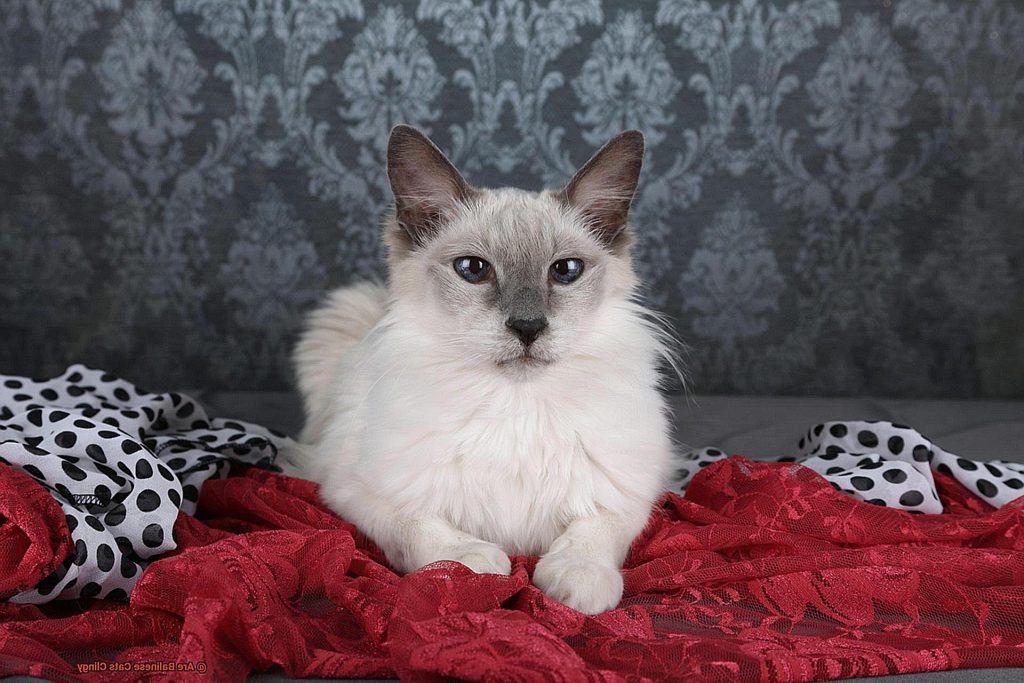Imagine coming home to a fluffy, blue-eyed companion who is always eager to greet you with purrs and headbutts.
That’s the reality for those lucky enough to have a Balinese cat in their life. These stunning felines have captured the hearts of many with their silky coats and loving personalities.
But what truly sets them apart is their clinginess – they just can’t seem to get enough of their humans. From following you around the house to snuggling up in your lap, Balinese cats are known for being “velcro cats.”
Let’s take a closer look at this unique breed and uncover the reasons behind their irresistible need for attention.
Are Balinese Cats Clingy?
Contents
However, there is a common misconception that all Balinese cats are clingy. As an expert on Balinese cats, let me clear the air and explain the distinction between a clingy and loving Balinese cat.
What is clinginess in cats?
First, let’s define what we mean by “clinginess” in cats. Clinginess can manifest in various ways, such as following their owners around, constantly seeking attention and physical contact, or displaying signs of distress when separated from their owners. While these behaviors may be seen in Balinese cats, it is crucial to understand that not all clingy behaviors are the same.
Understanding the difference between clingy and loving Balinese cats:
- Social Nature vs. Anxiety: Balinese cats are highly social creatures and crave human attention. They form strong bonds with their owners and can become distressed when left alone for extended periods. However, clinginess can also be a sign of anxiety or insecurity in cats. If your Balinese cat is exhibiting clingy behavior, observe and assess the situation carefully to determine the cause.
- Intelligence and Energy Levels: Balinese cats are known for their intelligence and high energy levels. They require mental and physical stimulation to prevent boredom. If their needs are not being met, they may turn to their owners for attention and entertainment. This can sometimes be mistaken for clinginess.
- Individual Personalities: Just like humans, every cat has its own unique personality. While Balinese cats are generally affectionate and social, some may naturally have a more independent personality and may not display clingy behavior at all.
Managing clinginess in Balinese cats:
If you feel that your Balinese cat’s clinginess is excessive or causing issues in your household, it is essential to seek advice from a veterinarian or a professional cat behaviorist. They can help identify any underlying causes for the behavior and provide solutions to address it.
The Siamese Heritage of Balinese Cats and Its Effects on Their Behavior
The Balinese cat is a beloved breed known for its striking appearance and endearing personality. But did you know that their behavior is heavily influenced by their Siamese heritage? This fascinating connection sheds light on why these cats are so affectionate and attached to their human companions.
Siamese cats have been cherished as pets for centuries, and it’s no surprise that their close cousin, the Balinese cat, shares many of the same traits. Both breeds are known for being vocal, affectionate, and highly social. This strong bond with their owners can often lead to clingy behavior, as they constantly seek out attention and physical contact.
But where does this desire for human interaction come from? The answer lies in their history as companion animals in ancient Siam (now Thailand). These cats were highly valued by royalty and were even considered sacred in some cases. They were treated like members of the family and were showered with love and affection.
This deep connection with humans has been passed down through generations of Siamese cats, including the Balinese breed. It’s ingrained in their DNA to crave human companionship and thrive off of the love and attention given to them. As a result, Balinese cats may not do well with prolonged periods of solitude and may become anxious or depressed if left alone for too long.
However, this strong attachment to humans also means that they can form deep and lasting bonds with their owners. They are incredibly loyal and loving creatures, always eager to be by your side and offer companionship. So while their clingy behavior may be overwhelming at times, it’s also a testament to their unwavering devotion.
As a cat owner, it’s important to understand the Siamese heritage of Balinese cats in order to better understand their behavior. Proper socialization and training can help balance out their neediness, while still maintaining a strong bond with their owners. It’s also essential to provide them with plenty of mental and physical stimulation to prevent boredom and potential destructive behaviors.
The Importance of Socialization for Balinese Cats
As cat lovers, we all know the joy of having a furry companion who greets us with love and affection every day. And when it comes to Balinese cats, their social and loving nature is one of their most endearing qualities. But did you know that this behavior is deeply ingrained in their DNA?
Balinese cats are closely related to Siamese cats, known for their vocal, loving, and social nature. This close bond with humans can be traced back to ancient Siam, where they were revered as sacred family members. This history explains why Balinese cats crave human interaction and thrive off of love and attention from their owners.
But as much as these feline friends may seem like natural social butterflies, it is important to understand the role of socialization in their behavior and overall well-being.
What is socialization, you may ask? It is the process of exposing a cat to different people, animals, and environments in a positive and controlled manner. For Balinese cats, this process is crucial as they are highly social creatures who require regular interaction and attention from their owners.
Proper socialization should start at an early age, between 3-9 weeks, when kittens are most receptive to new experiences. This includes introducing them to new people, animals, and environments in a positive way. Regular handling and playtime with different toys can also help kittens develop healthy social behaviors.
Continuing socialization throughout a cat’s life is equally important. Neglecting this can lead to behavioral issues such as shyness, anxiety, aggression towards people or other animals, excessive scratching or biting, and even depression.
On the other hand, proper socialization has many benefits for Balinese cats. It helps them feel more comfortable in new situations and reduces their fear of unfamiliar people or environments. It also teaches them how to interact with other animals and humans in a positive manner.
As an expert on Balinese cats, I have seen firsthand the impact of socialization on their behavior and well-being. My own Balinese cat, Fluffy, was a shy and anxious kitten until I made a conscious effort to socialize her. Now, she is a confident and social adult who loves meeting new people and exploring new places with me.
Managing Separation Anxiety in Balinese Cats
Balinese cats are known for their loving and social nature, often forming strong bonds with their owners. However, this can also make them prone to separation anxiety when left alone. As an expert on managing this common issue in Balinese cats, I have researched and gathered valuable insights on effective strategies to help cat owners tackle this problem.
It’s important to understand that separation anxiety is not a behavior that cats choose to exhibit. It’s a response to stress and fear triggered by being separated from their owners. Some cats may have a genetic predisposition to anxiety, while others may develop it due to past experiences or changes in their environment.

Creating a Stimulating Environment:
One way to alleviate separation anxiety is by providing a stimulating environment for the cat. This includes interactive toys, scratching posts, and perches for them to climb and play on while their owners are away. These activities can help keep the cat engaged and mentally stimulated, reducing their stress levels.
Establishing a Routine:
Balinese cats thrive on routine and predictability. Any sudden changes in their daily schedule can cause them stress and anxiety. To avoid this, it’s important for owners to establish a consistent routine for feeding, playtime, and other activities. This will help the cat feel secure and reduce their anxiety when left alone.
Gradually Acclimate to Being Alone:
It’s essential to gradually get the cat used to being alone. This can be achieved by leaving them alone for short periods of time at first and gradually increasing the duration as they become more comfortable. Giving them a safe space, such as a cozy cat bed or room with their favorite toys, can also help ease their anxiety.
Seek Professional Help:
In severe cases of separation anxiety, it may be necessary to seek professional help from a veterinarian or animal behaviorist. They can provide guidance on behavior modification techniques or medication if needed. It’s always best to consult with a professional for proper diagnosis and treatment.
Maintain a Calm and Patient Approach:
Lastly, it’s crucial for owners to remain calm and patient when dealing with their cat’s separation anxiety. Punishing or scolding the cat will only make the situation worse and can damage the bond between owner and pet. Instead, use positive reinforcement techniques to encourage good behavior.
Dealing with Demanding Behavior from Balinese Cats
As a proud owner of a Balinese cat, I understand the joys and challenges of having one as a pet. These intelligent and affectionate cats are known for their strong bonds with their owners, but this can also lead to demanding behavior. If you’re struggling to manage your Balinese cat’s clinginess, don’t worry – you’re not alone. As an expert on this breed, I’ll share some practical tips to help you handle your cat’s demanding behavior in a healthy and positive way.
Understanding the Root Cause
First and foremost, it’s important to understand that demanding behavior is a natural trait of Balinese cats. They are highly social creatures and crave constant interaction and attention from their owners. This can manifest in behaviors like following you around, meowing excessively, and even becoming aggressive when their needs are not met. It’s essential to recognize that this behavior is not a sign of disobedience or bad behavior, but rather a result of their breed’s personality.
Provide Mental and Physical Stimulation
One effective way to deal with demanding behavior from Balinese cats is by providing plenty of mental and physical stimulation. These cats are intelligent and need mental exercises to keep them engaged and happy. Interactive toys, puzzle feeders, and designated playtime where you actively engage with your cat are great ways to stimulate their minds. Physical activities like playing fetch or chasing a laser pointer can also keep them physically active and fulfill their need for attention.
Establish a Routine
Cats thrive on routine, and this is especially true for Balinese cats. By setting a consistent schedule for playtime, feeding, and other activities, you can help your cat feel more secure and reduce its need for constant attention. Be sure to stick to the routine as much as possible to avoid triggering anxiety in your cat.
Set Boundaries
It’s essential to set boundaries with your Balinese cat and not give in to its demands every time. By reinforcing positive behavior, such as sitting calmly and waiting for attention, you can help your cat understand that it will be rewarded for patient and calm behavior. This will also help establish a healthy balance between giving your cat attention and respecting your own boundaries.
Individual Personalities: Why Some Balinese Cats Are More Independent Than Others
Are you a proud owner of a Balinese cat? These elegant and affectionate felines are known for their loving nature and loyal companionship. However, as with any breed, each Balinese cat has its own unique personality, and some may be more independent than others. In this blog post, we will explore the reasons behind varying levels of independence in Balinese cats and provide tips for managing their clingy behavior.
Understanding the independent nature of Balinese cats:
While Balinese cats are often described as affectionate and loving towards their owners, they are also known to have an independent streak. This means that they may not constantly seek attention or cuddles from their owners like other breeds such as Siamese or Ragdoll cats. Instead, they may prefer to spend time alone or entertain themselves with toys and activities.
Factors that influence a cat’s level of independence:
- Genetics: As with any breed, genetics play a significant role in a cat’s personality. Some Balinese cats may inherit a more independent nature from their parents, while others may be more social and clingy.
- Upbringing: A cat’s upbringing also plays a crucial role in shaping their personality. Kittens who are exposed to different people and environments at a young age are more likely to develop a confident and independent personality.
- Individual experiences: Just like humans, cats can also be affected by their past experiences. If a cat has had negative experiences with humans or other animals, they may become more withdrawn and less social.
- Socialization during kittenhood: The socialization period for kittens is between 2-7 weeks of age. During this time, they learn how to interact with other animals and humans. Kittens who have not been adequately socialized may develop fear or aggression towards humans, leading to clinginess.
- Environment: A cat’s environment can also influence their level of independence. If they have access to plenty of toys and activities to keep them stimulated, they may not seek as much attention from their owners.
Tips for Bonding with Your Clingy Balinese Cat
You may be familiar with their affectionate and clingy nature. While their constant need for attention can be endearing, it can also become overwhelming for some owners. But fear not, as an expert on bonding with clingy Balinese cats, I am here to provide you with some helpful tips.
First and foremost, it is important to understand that clinginess is a natural trait in Balinese cats. This behavior stems from their deep attachment to their owners and their need for social interaction. Instead of trying to eliminate this behavior, it is crucial to find ways to manage it and strengthen the bond between you and your cat.
One of the best ways to manage your clingy Balinese cat’s behavior is by establishing a routine. Cats thrive on routine and structure, so having a consistent daily schedule will help them feel more secure and less anxious. This will also help them know when to expect attention from you, reducing their need to constantly seek it.
Despite their clingy nature, Balinese cats still need quality one-on-one time with their owners. Set aside some dedicated time each day to play with your cat or simply sit with them and give them undivided attention. This will not only strengthen your bond but also provide your cat with the mental and physical stimulation they need.
In addition to one-on-one time, providing enrichment activities is also beneficial for Balinese cats. These intelligent and curious creatures need mental stimulation to prevent boredom and potential destructive behaviors. Interactive toys and games are a great way to keep them engaged and entertained while bonding with them.
Another way to bond with your Balinese cat is through grooming sessions. These cats have long, silky coats that require regular grooming. Use this as an opportunity to spend quality time with your cat by talking softly and giving them treats. This grooming time can be calming for both you and your cat while strengthening your bond.
It is also crucial to respect your cat’s personal space. While they may crave attention, they also need time alone. Allow them to come to you when they want affection, rather than constantly seeking it out. This will also help prevent potential behavioral issues such as separation anxiety.
Lastly, consider getting another cat as a companion for your clingy Balinese cat. They are known to do well with other cats, especially if they are from the same breed. This will provide them with a constant playmate and reduce their need for constant attention from you.
Conclusion
In conclusion, Balinese cats are a unique and delightful breed that captures the hearts of many with their striking appearance and affectionate nature. Their clinginess is just another endearing quality that sets them apart from other cats. However, it’s important to note that not all Balinese cats exhibit this behavior and understanding the difference between clinginess and love is crucial.
Genetics, upbringing, and individual experiences can all play a role in a cat’s level of independence. To manage clinginess in your Balinese cat, establishing a routine and providing mental and physical stimulation are key. Additionally, bonding with your cat through one-on-one time, grooming sessions, and respecting their personal space can help strengthen your bond while also addressing their need for attention. And if you’re looking for a constant companion for your clingy Balinese cat, consider getting another feline friend as a playmate.
Overall, owning a Balinese cat is an enriching experience filled with endless love and devotion. So if you’re fortunate enough to have one in your life, cherish their clinginess as a testament to their unwavering loyalty to you.






